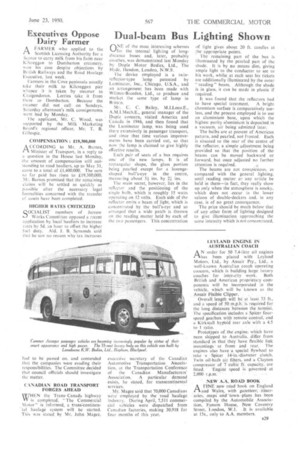Dual-beam Bus Lighting Shown
Page 35

If you've noticed an error in this article please click here to report it so we can fix it.
ONE of the most interesting schemes for the internal lighting of longdistance buses and, later, probably coaches, was demonstrated last Monday by Duple Motor Bodies, Ltd., The 1-1Ac, Hendon, London, N.W.9.
the device employed is a twinreflector-type lamp patented by Lurninator, Inc„ Chicago, U.S.A., and an arrangement has been made with Wilmot-Breeden, Ltd., to produce and market the same type of lamp in Britain.
Mr. C. C. Bailey, M.I.Loco.E., A.M.I.Mech.E., general manager of the Duple concern, visited America and Canada in 1946, and then found that the Luminator lamp, was being used there extensively in passenger transport, and since that time various improvements have been carried out, so that now the lamp is claimed to give highly effective results.
Each pair of seats of a bus requires one of the new lamps. It is of rectangular shape, the glass portion being pearled except for a lozengeshaped bull's-eye in the centre, measuring about 3a ins. by 21 ins.
The main secret, however, lies in the reflector and the positioning of the single bulb, which is roughly 15 watts operating on 12 volts. Each side of the reflector emits a beam of light, which is concentrated by the bull's-eye and so arraneed that a wide patch is thrown on the reading matter held by each of the two passengers. This concentration of light giveS about 20 ft. candles at the appropriate points.
The remaining part of the bus is illuminated by the pearled part of the shade. It is by no means dim, giving ample light to the conductor to see to his work, whilst at each seat his tickets are additionally illuminated by the outer "reading" beam. Although, the shade is in glass, it can be made in plastic if required.
It was found that the reflectors had to have special treatment. A bright chromium surface is comparatively useless, and the process employed is to use an aluminium base, upon which the highest purity aluminium is deposited in a vacuum, air being admitted later.
The bulbs are at present of American pattern, and pearled, not frosted.' Each is situated to the rear of the centre of the reflector, a simple adjustment being provided so that the position of the beams can be moved backward or forward, but once adjusted no further attention is required.
The beams are not conspicuous, as compared with the general lighting, until reading matter or any article be held in them—in fact, they really show up only when the atmosphere is smoky, which does not occur in the lower saloon of double-deckers and. • in any case, is of no great consequence.
The price should be Much below that of any other form of lighting designed to give illumination approaching the same intensity which is not concentrated,












































































